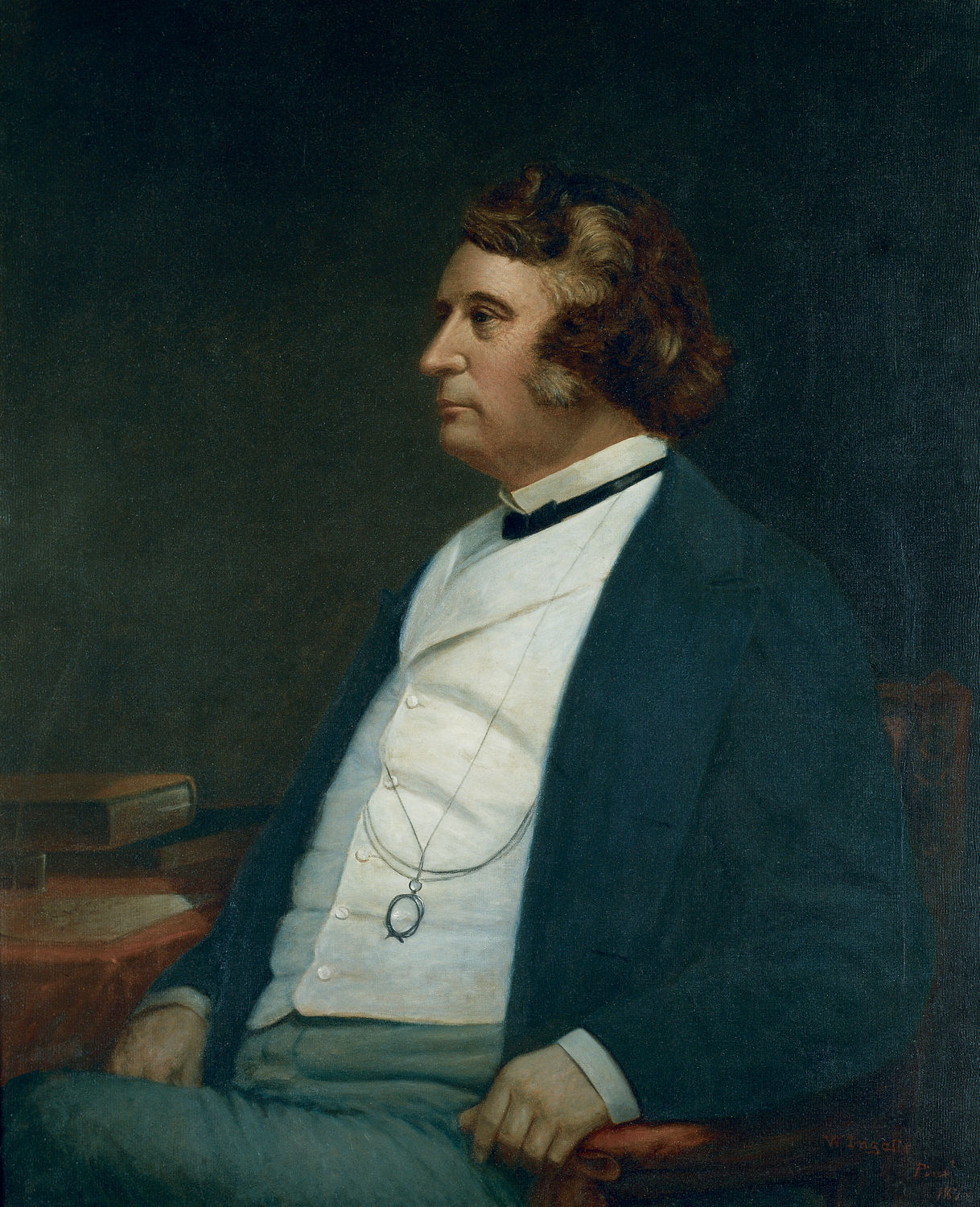
| Title | Charles Sumner |
| Artist/Maker | Walter Ingalls ( 1805 - 1874 ) |
| Date | 1873 |
| Medium | Oil on canvas |
| Dimensions | Sight: h. 43.875 x w. 35.375 in. (h. 111.4425 x w. 89.8525 cm)
Framed: h. 60.25 x w. 51.75 in. (h. 153.035 x w. 131.445 cm) |
| Credit Line | U.S. Senate Collection |
| Accession Number | 32.00016.000 |
With his large head, thick hair and muttonchops, and broad torso, abolitionist Charles Sumner presented a powerful image. This likeness of Sumner by Walter Ingalls resembles in several regards an 1860 “Imperial” photograph (24 x 20 inches) by Mathew Brady. The photograph, like the painting, shows Sumner facing left. His body is at a three-quarter angle so that the torso opens up, revealing an expanse of white waistcoat, watch fob, and folding eyeglasses suspended from a slender cord or chain. However, Ingalls repositioned the head into profile and also placed the disproportionately short left thigh parallel to the picture plane. The conflict of the planar head and thigh with the angled torso is awkward and distracting. The profile head (with less unruly hair than in the photograph) is, however, calm and pensive, and its greater formality is seconded by the books and papers on the table.
According to an unsigned document among the records of the Joint Committee on the Library, Sumner sat for Ingalls in 1873 in a temporary studio at the U.S. Capitol. The resulting portrait was purchased by the committee in 1886, 12 years after Sumner’s death.
Walter Ingalls, a prolific portrait artist, was born in Canterbury, New Hampshire, in 1805. He was self-taught and widely traveled, and his genial personality won him such celebrated clients as scientist Louis Agassiz and Pope Pius IX. Ingalls usually spent part of each year in Washington, D.C., and he died in the nearby town of Oakland, Maryland, in 1874. A number of his paintings are held by the New Hampshire Historical Society in Concord.
Charles Sumner, a U.S. senator from Massachusetts and a passionate abolitionist, was born in Boston. After law school he spent time in Washington, D.C., where he met with Chief Justice John Marshall and listened to Henry Clay debate in the Senate Chamber. Unimpressed with the politics of Washington, he returned to Massachusetts, where he practiced law, lectured at Harvard Law School, and published in the American Jurist. Following a three-year study tour of Europe, Sumner resumed his law practice with little enthusiasm. Then, in 1845, he was invited to make a public Independence Day speech in Boston. This event was a turning point in his career, and he soon became widely known as an eloquent orator.
Six years later, Sumner was elected to the U.S. Senate by a coalition of Free-Soilers and Democrats. A strong opponent of slavery, he denounced the Fugitive Slave Law and attacked the Kansas-Nebraska Act, which repealed the Missouri Compromise by giving territories north of latitude 36°30' (the southern border of Missouri) the option of legalizing slavery. Sumner's strong political opinions brought angry reactions from Southern senators and branded him a radical. In the mid-1850s, the senator was influential in organizing the Republican Party. On May 20, 1856, he delivered his famous Senate speech, "The Crime against Kansas." Calling the Kansas-Nebraska Act a "swindle," Sumner also denounced Senators Andrew P. Butler of South Carolina and Stephen A. Douglas of Illinois. Two days later, Butler's cousin, Representative Preston Brooks of South Carolina, beat Sumner over the head with a cane on the floor of the Senate, severely injuring him.
During the next three and a half years, Sumner tried to recover from the assault. In 1857, despite his absence from Capitol Hill, the Massachusetts legislature unanimously reelected Sumner to the Senate. He returned to Washington, D.C., in 1859 and again took up the abolitionist cause, delivering a speech on the "Barbarism of Slavery." Appointed chairman of the Senate Committee on Foreign Relations in 1861, Sumner played an important role in avoiding violent conflict with Great Britain and France during the crucial opening phase of the Civil War. He supported President Abraham Lincoln's Emancipation Proclamation of 1863, and, during the Reconstruction Era after the Civil War, he focused his efforts on securing equal rights for African Americans. Sumner disagreed strongly with President Andrew Johnson's Reconstruction plans and played a major role in the move to impeach him. Sumner likewise differed with President Ulysses Grant on many postwar issues. Grant retaliated by persuading the Republican conference to remove Sumner as chairman of the Foreign Relations Committee in 1871. After Sumner died suddenly of a heart attack in March 1874, his body lay in state in the Rotunda of the Capitol. His greatest role in the U.S. Senate was his tireless advocacy of civil rights for African American citizens.